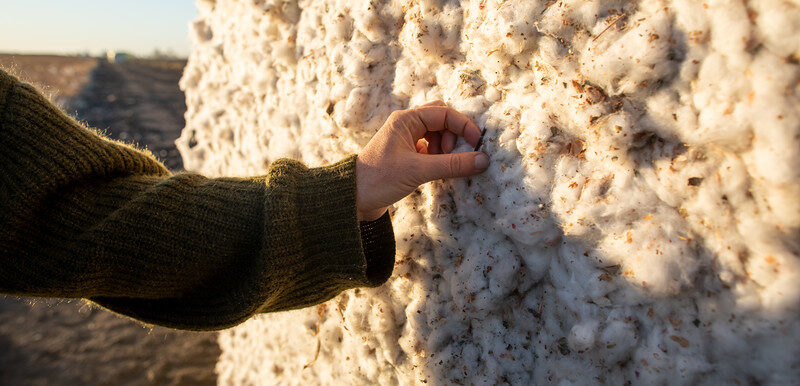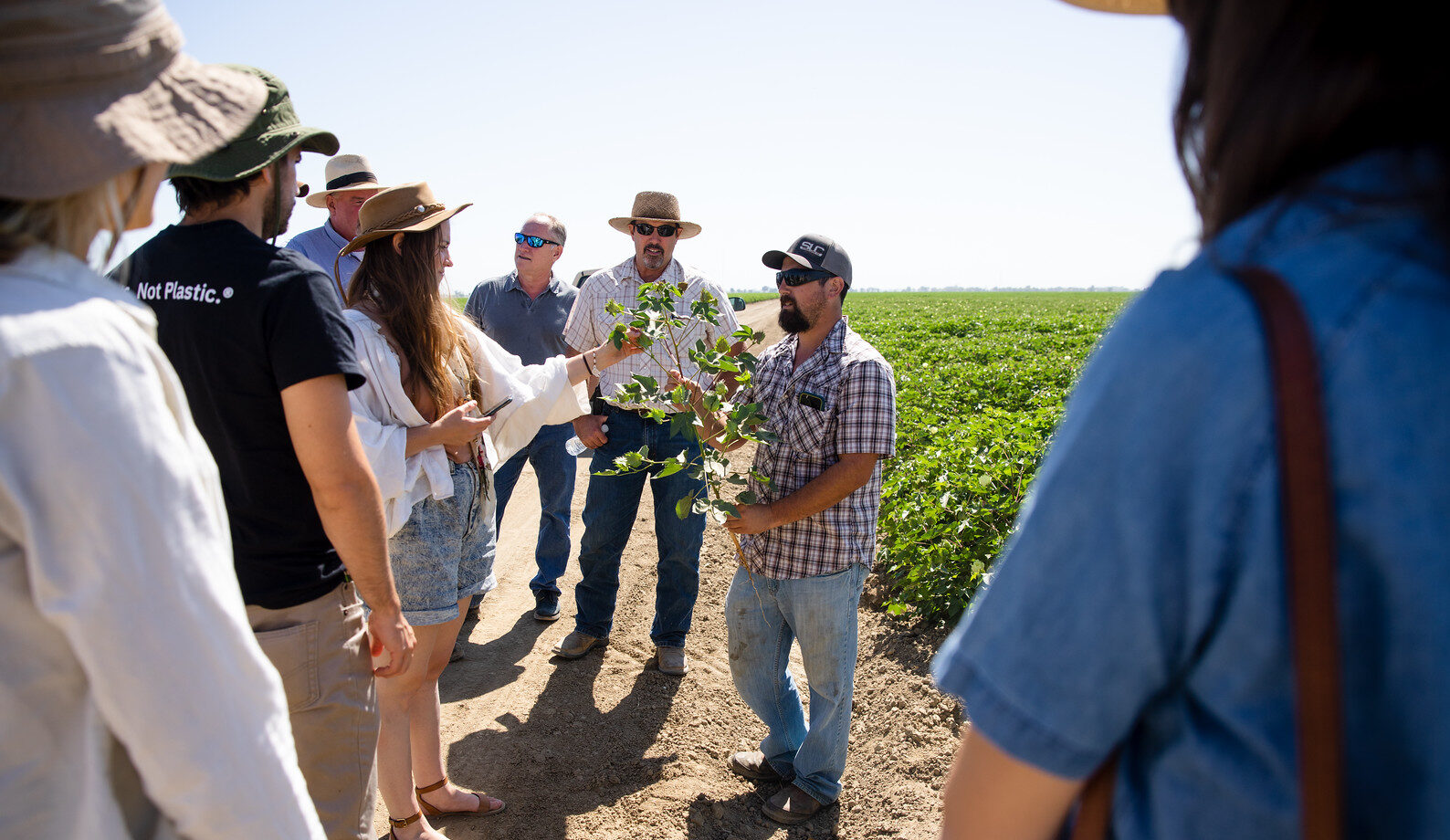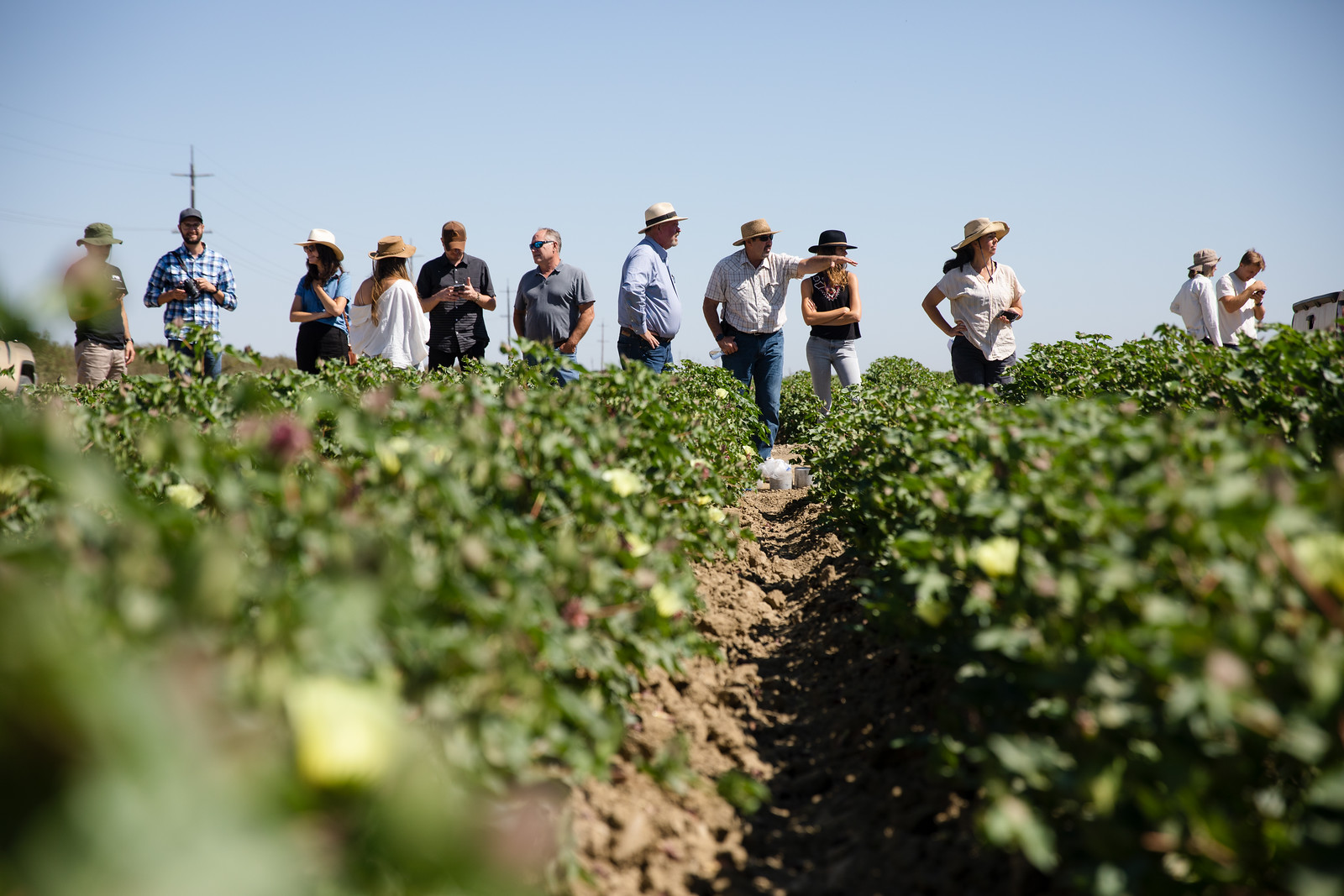The California Cotton & Climate Coalition is working to restore our connection with our working landscapes by developing a model to lift up regionally produced textiles that prioritize soil health, support rural economies, and mitigate climate change in California’s Central Valley.
In the fall of 2020, a coalition of farmers, brands, designers, researchers, and leaders in the textile industry came together to reimagine the way clothing is produced, distributed, and, ultimately, consumed. Based on practices established through Fibershed’s Climate Beneficial Program™, leaders at White Buffalo Land Trust, Torus Consulting, and Materevolve joined forces to form the California Cotton & Climate Coalition (C4). The coalition works to build a supply chain that starts on the farm — protecting rural jobs and enabling farmers to prioritize soil health in cotton growing systems — and connects those growers directly with brands to sell Climate Beneficial™ cotton.
Rejecting “Business As Usual” In the Fashion Industry
C4 is reversing the industrial formula for producing clothing. In the predominant fast-fashion culture, the most power to develop pricing for a finished good sits with the brand, which can source material from a wide range of global supply chains. Whereas growers must farm the same land, with the same soil, and face the same challenges with water and temperature year after year without the ability to make sweeping choices that would allow them to move and farm elsewhere if things didn’t work out. Brands (especially large ones) have the strongest line of communication to those purchasing clothing. They have PR firms and marketing teams, which allows them to influence the public narrative around what is “sustainable” and what is not. This is not necessarily a negative, as it can be a place where brands utilize their power and wield it for good, but it can also be a place where brands promote products that are more about meeting a margin than meeting an environmental and social benefit outcome.
This business model creates ongoing pressure for brands to purchase textiles for the lowest price, and for farmers to produce the lowest-cost fibers. The result, in most cases, is environmental degradation, low-wage jobs, and a growing reliance on overseas markets with far fewer labor protections. These business practices generally aim to produce the lowest-cost goods that consumers have now come to expect. This system has created a laundry list of externalities with a laundry list of price tags associated with them. Those externalities are pushed onto ecosystems and human communities and not paid for by those making or buying these goods.
In this conventional supply chain, brands are not connected to the farmers producing their material goods, let alone do they understand the practices used to produce these materials. Larger-scale brands work diligently to maintain a consistent profit margin year after year. Yet, farms (particularly small and mid-sized ones) struggle to maintain consistent margins year after year because they have little control over the prices they receive for their raw goods. Pricing is set by commodity markets that they do not control. Commodity markets do not take into account a changing climate, making it increasingly difficult for growers to adapt to shifting conditions in their regions. While most farmers are very interested in learning about and engaging in more sustainable growing methods, there is little to no room in a farm’s business model to test and implement new practices.
This deeply entrenched system disincentivizes taking risks to transition to agricultural practices that build soil health and ecological resilience. Brands, farmers, and merchants are all trying to exist in our hyper-competitive and consumer-driven world, and the true needs and value of agriculture are too often obscured by unrealistic expectations for cheap clothing. In this scenario — what is our current reality — the brands competing to produce and sell the cheapest goods “win” while consumers and the environment lose.
Building A Farm-Forward Supply Chain
The goals of C4 reflect a growing movement for transparency and accountability in the clothing industry. C4 is working to bring textiles and clothing to consumers in a traceable manner that highlights farm and production choices. C4 ensures that farmers can viably trial practices that build soil biology, improve infiltration, and restore organic carbon. It does this by guaranteeing that the grower has a premium price that can support them to take some level of risk. Participating in C4 adds no cost to the farmer nor the price o the cotton, and C4 does not profit from the sale of cotton.
C4 also works with the brand partners through a coalition focusing on on-farm educational experiences. It also includes assisting brands to work directly with the early stage aspects of the supply network, making it possible for textile companies to work pre-competitively to co-develop yarn and scaffold mill minimums together as a means to make doing farm-forward business practice increasingly accessible.
C4 is revaluing the role of agriculture within textile production and, in doing so, lifting up the true cost of producing domestic, climate-beneficial cotton. This work of developing farm forward and pre-competitive systems is an incremental, long-term process that must be matched with long-term commitments and relationships. The coalition’s work includes ongoing technical assistance, trials and education, and abundant transparency.
By working together in a pre-competitive manner, risk is shared by all partners, which is critical to implementing innovative practices on-farm, in the mill, and in the development of new goods. These ongoing partnerships honor all of the human relationships that make our textile culture manifest.
Regenerating Our Farming Systems Through Collaboration
This approach requires a commitment to deepening a company’s understanding of the realities of agriculture and the ways in which cotton is purchased direct from field and into a supply network — a process that takes far more work. This growing movement currently includes three farms, ten companies, three textile development partners, and countless technical service providers and scientists, all with deep roots to the land, the California bioregion, and the future of our material culture.
Each partner plays a crucial role in building a circular model that regenerates our soil, supports growers, and protects high-quality jobs in rural California. By acting as a coalition in a value-add process, we can work pre-competitively to innovate.
We invite more brands to join the movement to rebuild the textile economy from the soil up, and encourage you to shop Climate Beneficial™ cotton in support of fair, transparent prices that advance resilient agricultural systems.
—
Learn more about the California Cotton and Climate Coalition.
Images by Paige Green Photography




